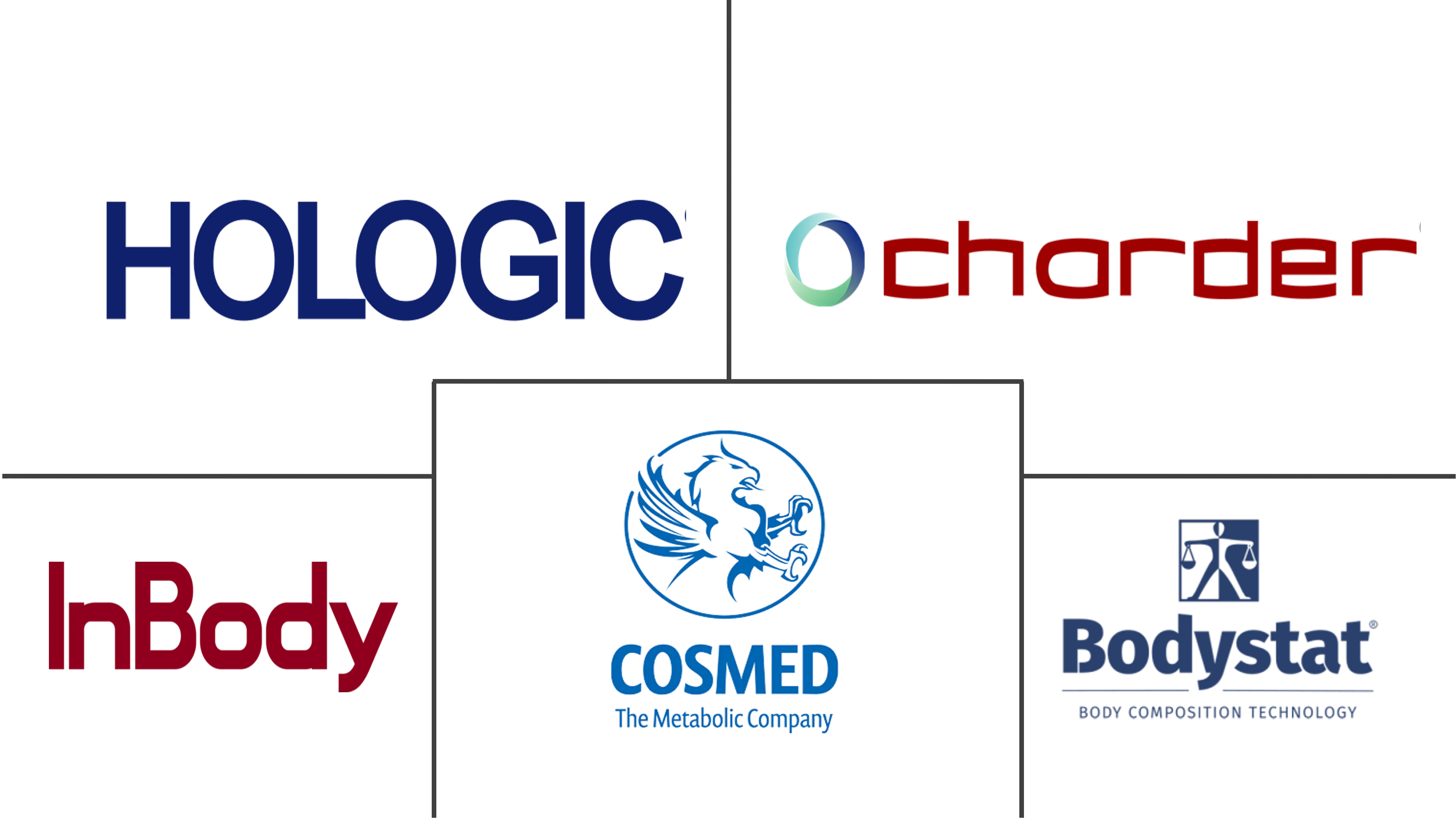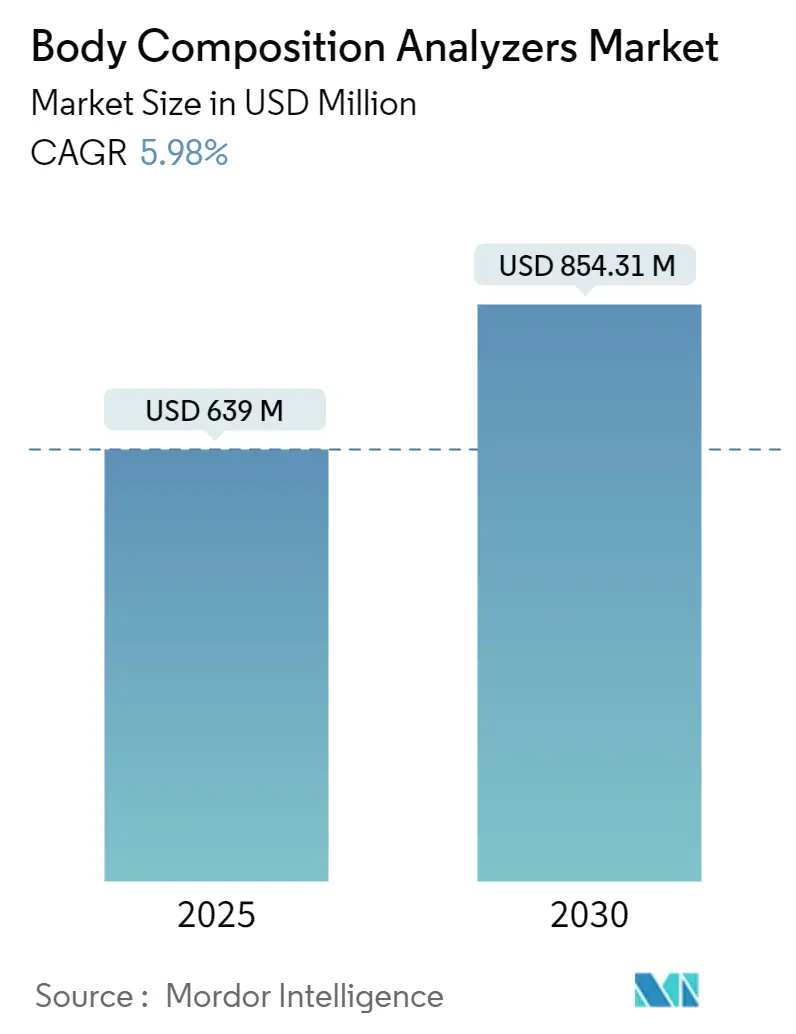
Body Composition Analyzers Market Analysis
The Body Composition Analyzers Market size is estimated at USD 639.00 million in 2025, and is expected to reach USD 854.31 million by 2030, at a CAGR of 5.98% during the forecast period (2025-2030).
The body composition analyzer industry is experiencing significant transformation driven by shifting global health demographics and evolving healthcare priorities. According to the World Obesity Atlas, approximately one billion people globally, including one in five women and one in seven men, are predicted to live with obesity by 2030, highlighting the growing need for body composition analysis solutions. Healthcare systems worldwide are adapting their infrastructure to accommodate this demographic shift, with many facilities incorporating advanced body composition analyzers into their standard diagnostic protocols. The integration of these analyzers into routine health assessments represents a fundamental change in how healthcare providers approach patient evaluation and treatment planning.
The market is witnessing a surge in strategic partnerships between technology providers and fitness facilities, creating new channels for consumer access to professional-grade body composition analysis. A notable example is the January 2024 collaboration between Orangetheory Fitness and InBody, which has made professional body composition analysis available across more than 1,400 participating studio locations. These partnerships are revolutionizing how individuals track their fitness progress and understand their body composition, making professional-grade analysis more accessible to the general public. The trend toward integration of body composition analysis in fitness facilities is reshaping the BCA industry landscape and creating new opportunities for market expansion.
Healthcare infrastructure development is playing a crucial role in market evolution, with governments implementing comprehensive strategies to address health monitoring and obesity management. For instance, Australia's National Obesity Strategy (2022-2032) represents a significant 10-year framework focused on prevention, education, and treatment of overweight and obesity, incorporating body composition measurement as a key diagnostic tool. Similar initiatives are being adopted globally, with healthcare facilities upgrading their diagnostic capabilities to include advanced body composition analysis equipment. This systematic approach to health monitoring is driving the standardization of body composition monitoring in healthcare settings.
The research and development landscape in body composition analysis is experiencing unprecedented growth, with continuous innovations in measurement accuracy and user experience. The field's scientific validity is evidenced by over 5,500 research papers published on precision in body composition analysis, spanning applications in medicine, nutrition, sports, and obesity management. Research institutions and manufacturers are collaborating to develop more sophisticated analysis algorithms and measurement techniques, leading to improvements in accuracy and reliability. These advancements are enabling healthcare providers to make more informed decisions about patient care and treatment strategies, further solidifying the role of medical body composition analyzers in modern healthcare delivery.
Body Composition Analyzers Market Trends
Large Pool of Obese Patients and Increasing Prevalence of Metabolic Disorders
The growing burden of obesity and metabolic disorders worldwide is creating an urgent need for body composition analysis tools. According to the World Obesity Atlas 2023, the prevalence of obesity alone is anticipated to rise dramatically from 14% to 24% among the population from 2020 to 2035, potentially affecting nearly 2 billion adults, children, and adolescents globally by 2035. This rising trend is particularly concerning among children and adolescents, with projections showing an increase from 10% to 20% among boys and 8% to 18% among girls worldwide during the same period. The significant increase in obesity rates is driving healthcare providers to adopt advanced body fat measurement tools for accurate diagnosis and monitoring of patient health status.
The prevalence of diabetes, a major metabolic disorder where body fat measurement and body mass index (BMI) maintenance is crucial, is also showing an alarming upward trend. According to the International Diabetes Federation (IDF) data updated in June 2023, more than 1.3 billion people worldwide could be living with diabetes by 2050. The condition is strongly associated with excess body fat, as diabetic patients often exhibit increased body fat mass resulting in increased lipid accumulation in muscle cells. This creates a growing need for precise body composition analysis tools that can provide accurate measurements of segmental and overall body composition, enabling better diagnosis of diabetes risk and optimization of treatment options.
Technological Advancements
The integration of advanced technologies into body fat analyzer devices is revolutionizing the way body composition is measured and monitored. Recent developments include the incorporation of deep learning algorithms and three-dimensional body scans, as evidenced by research published in Communication Medicine in January 2024, where the Pennington Biomedical team developed and validated a deep learning model that generates accurate dual-energy X-ray absorptiometry (DXA) scans from three-dimensional optical body scans. This advancement has made compositional analysis of the whole body and specified subregions more accessible and easier to obtain, significantly improving the utility of these devices in clinical settings.
The market is witnessing continuous innovation in device capabilities and form factors. For instance, in November 2023, Withings launched a robust Body Smart scale for PARIS 2024, enabling users to perform in-depth health scans using Withings Precision Technology with multi-frequency bioelectrical impedance analysis (BIA). Similarly, in March 2024, InBody launched the next-generation bioimpedance analyzer - InBody 380 and InBody 580, featuring advanced capabilities like precise body fat measurement, enhanced muscle mass analysis, and revolutionary segmental analysis. These technological improvements have significantly reduced analysis time while improving accuracy and user experience, making body composition analysis more accessible to healthcare providers and consumers alike.
Rising Awareness for Health and Fitness
The increasing consciousness about health and fitness is driving the demand for fitness testing equipment across various settings. According to an article published in Acta Biomed in July 2022, low muscle mass is associated with higher body image and shape dissatisfaction, highlighting the growing awareness among youth regarding the importance of body composition assessment and muscle-mass building activities. This awareness is further amplified by social media platforms, which, according to research published in BMC Public Health in December 2022, play a crucial role in improving early diagnosis of metabolic diseases and facilitating behavior change techniques through providing social support and emphasizing health consequences.
The fitness industry's evolution has created a more sophisticated consumer base seeking detailed insights into their body composition. According to an article published in the Journal of Exercise Rehabilitation in October 2023, body composition has become recognized as essential to maintaining a healthy body, work efficiency, and athletic performance. This growing understanding has led to increased adoption of fitness assessment equipment in various settings, from fitness centers to home use. The trend is supported by the launch of new consumer-friendly devices, such as Amazfit's Body Composition Analyzer Mat in March 2024, which provides comprehensive full-body composition analysis through smart software features and detailed analysis capabilities.
Segment Analysis: By Product
Bio-impedance Analyzer Segment in Body Composition Analyzers Market
The bio-impedance analyzer segment dominates the body composition analyzers market, commanding approximately 40% of the total market share in 2024. This segment's leadership position is attributed to its advanced and accurate technology, along with strategic initiatives taken by market players. The segment has shown remarkable growth potential, projected to grow at nearly 7% from 2024 to 2029, the highest among all segments. The growth is primarily driven by the increasing development of technologically advanced products and rising adoption in healthcare facilities. For instance, in March 2024, InBody launched the InBody 380 and InBody 580 body composition analyzers, demonstrating continuous innovation in this segment. The segment's success is further bolstered by its non-invasive nature, precise measurements, and the ability to provide comprehensive body composition analysis, including fat, muscle, and water content measurements.
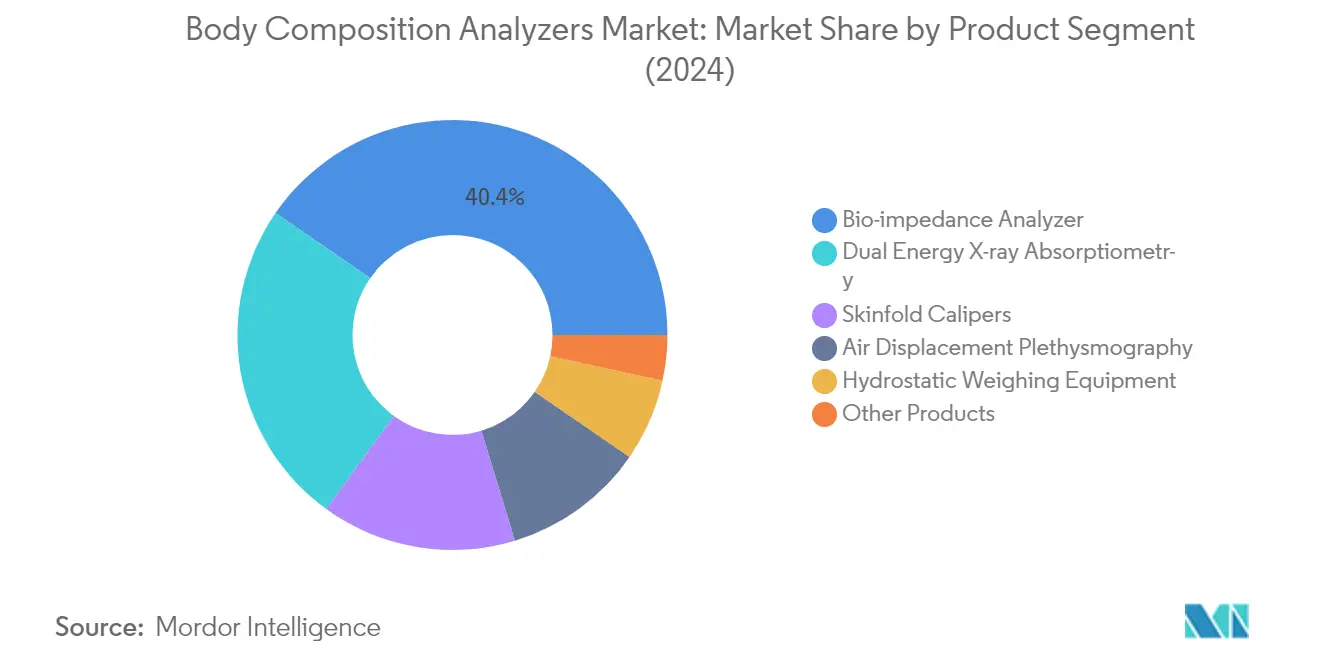
Remaining Segments in Body Composition Analyzers Market
The market encompasses several other significant segments, including dual-energy X-ray absorptiometry (DEXA scanner), skinfold calipers, air displacement plethysmography, hydrostatic weighing equipment, and other specialized products. DEXA systems represent the second-largest segment, valued for their high precision in measuring bone density and body composition. Skinfold calipers maintain their relevance due to their cost-effectiveness and convenience, while air displacement plethysmography is gaining traction for its non-invasive approach and accuracy in measuring body density. Hydrostatic weighing equipment, though smaller in market share, remains the gold standard for body fat measurement in research settings. Each of these segments serves specific needs in various settings, from clinical applications to fitness centers, contributing to the overall market diversity and growth.
Segment Analysis: By End User
Hospitals Segment in Body Composition Analyzers Market
The hospitals segment dominates the body composition analyzers market, commanding approximately 54% of the total market share in 2024. This significant market position is primarily attributed to hospitals being the first point of contact for the obese population and their easy accessibility to a large proportion of the population due to various diseases. The segment's dominance is further strengthened by the increasing number of hospitals and bariatric centers across the globe, coupled with various initiatives taken to provide advanced solutions to patients. For instance, in November 2023, the Apollo Institute of Bariatrics, Chennai, India, launched an anti-obesity program named 'MOULD', which incorporates body composition analysis and co-morbidity assessments. Additionally, the accreditation of hospitals for obesity medicine programs, such as NYC Health + Hospitals/Bellevue's accreditation for the Metabolic and Bariatric Surgery Accreditation and Quality Improvement Program (MBSAQIP) in October 2023, demonstrates the growing focus on obesity management in hospital settings.
Fitness Clubs and Wellness Centers Segment in Body Composition Analyzers Market
The fitness clubs and wellness centers segment is projected to exhibit the highest growth rate of approximately 7% during the forecast period 2024-2029. This robust growth is driven by the increasing health consciousness among people and the expanding network of fitness centers globally. The segment's growth is supported by the launch of new products specifically designed for fitness professionals, such as InBody's launch of InBody 380 in March 2024, which offers comprehensive solutions for fitness and wellness professionals. The expansion of fitness clubs across various regions, exemplified by American International College's launch of a new Center for Sports Physiology and Exercise Testing (CSPET) in April 2024, equipped with body composition testing capabilities, further demonstrates the segment's growth potential. Additionally, universities and educational institutions are increasingly incorporating body composition analysis services in their wellness centers, as evidenced by North Dakota State University Wellness Center's comprehensive fitness assessment offerings in February 2024.
Remaining Segments in End User Market
The academic and research centers segment, along with other end users including home users and government/military healthcare facilities, play crucial roles in the body composition analyzers market. Academic and research centers contribute significantly through their research activities and development of novel approaches in body composition analysis, particularly in studying obesity and diabetes. The increasing research and development funding, such as the CDC's High Obesity Program (HOP) grants to sixteen universities in 2023, strengthens this segment's importance. The other end users segment, which includes home users and military healthcare facilities, is gaining traction due to the rising demand for portable and cost-effective body composition analyzers for personal use and the increasing adoption of these devices in military fitness assessment programs.
Body Composition Analyzers Market Geography Segment Analysis
Body Composition Analyzers Market in North America
North America represents a significant market for body composition analyzers, driven by advanced healthcare infrastructure, a high prevalence of obesity, and increasing health consciousness among the population. The region benefits from the presence of major market players and early adoption of innovative healthcare technologies. The United States dominates the regional market, followed by Canada and Mexico, with factors such as increasing research activities, growing fitness centers, and rising awareness about body composition monitoring contributing to market growth.
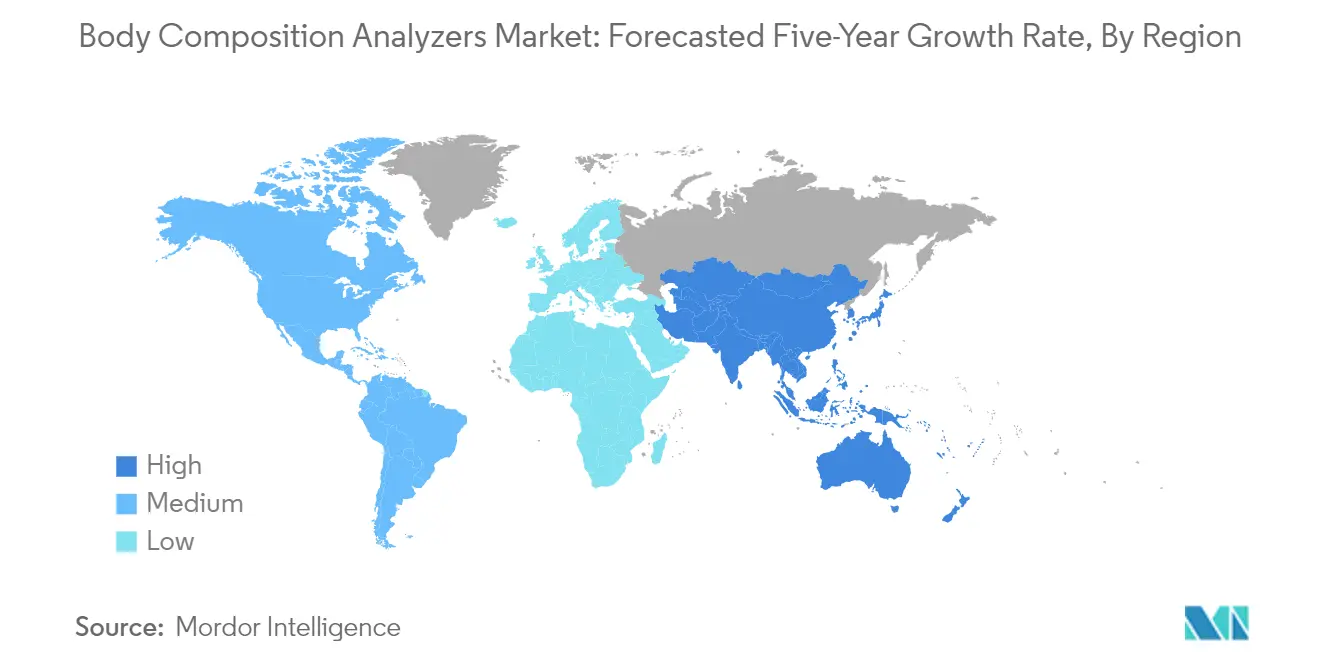
Body Composition Analyzers Market in the United States
The United States leads the North American market with approximately 34% share of the global BCA market in 2024. The country's dominance is attributed to factors such as the rising prevalence of obesity and other metabolic disorders, the increasing geriatric population, and the strong foothold of key market players. The country has witnessed significant technological advancements in body composition analysis using artificial intelligence, with companies like MEDICAL IP receiving FDA clearance for AI software for whole-body composition CT quantification. The presence of established healthcare infrastructure and increasing health awareness among the population further strengthens the market position.
Body Composition Analyzers Market in Canada
Canada demonstrates promising growth potential with an expected CAGR of approximately 5% during 2024-2029. The market is driven by rising awareness among the population regarding physical activity and healthy lifestyles, coupled with increasing new product launches by key players. The country has witnessed several strategic initiatives like collaborations and service expansions undertaken by industry participants. The Canadian government's increasing focus on healthcare infrastructure development and various initiatives to raise awareness regarding childhood obesity and chronic diseases further contribute to market growth.
Body Composition Analyzers Market in Europe
Europe represents a mature market for body composition analyzers, characterized by sophisticated healthcare systems and an increasing focus on preventive healthcare. The region benefits from strong research and development activities, particularly in countries like Germany, France, and the United Kingdom. The presence of major manufacturers and increasing adoption of advanced healthcare technologies contribute to market growth. The region has witnessed significant developments in terms of product innovations and strategic expansions by key market players.
Body Composition Analyzers Market in Germany
Germany maintains its position as the largest market in Europe, holding approximately 21% share of the European BCA market in 2024. The country's market leadership is supported by factors such as a high population suffering from metabolic disorders and an increase in research studies demonstrating the utilization and benefits of body composition analyzers. The presence of key players like Seca, offering innovative products such as seca mBCA 555/554 and seca mBCA525, further strengthens the market position.
Body Composition Analyzers Market in France
France emerges as the fastest-growing market in Europe with an anticipated CAGR of approximately 6% during 2024-2029. The growth is driven by increasing investments by various firms to tackle wellness activities and the growing number of fitness centers in the country. The French market has witnessed significant expansion of fitness facilities, with companies like Self Esteem Brands signing master franchisee deals to expand their presence. The government's initiatives to promote health awareness and combat obesity further support market growth.
Body Composition Analyzers Market in Asia-Pacific
The Asia-Pacific region demonstrates significant growth potential in the body composition analyzers market, driven by increasing healthcare expenditure, rising awareness about fitness, and the growing prevalence of lifestyle-related diseases. The region benefits from the presence of major manufacturers, particularly in countries like Japan and South Korea. The market is characterized by increasing adoption of advanced healthcare technologies and a growing focus on preventive healthcare measures across major economies like China, Japan, India, Australia, and South Korea.
Body Composition Analyzers Market in China
China maintains its position as the largest market in the Asia-Pacific region, driven by the rising prevalence of metabolic disorders and the growing burden of obesity among the population. The country has witnessed significant technological advancements in body composition analyzers, with an increasing focus on developing innovative products. The Chinese government's strategic initiatives to address the overweight and obesity epidemic, particularly among children and adolescents, further strengthen the market growth potential.
Body Composition Analyzers Market in India
India emerges as the fastest-growing market in the Asia-Pacific region, driven by rising awareness among the population regarding physical activity and healthy lifestyles. The country has witnessed increasing new product launches and strategic initiatives by key market players. The growing burden of obesity and diabetes, coupled with increasing health consciousness among the population, creates significant opportunities for market expansion. The market benefits from various government initiatives promoting health awareness and fitness activities.
Body Composition Analyzers Market in Middle East & Africa
The Middle East & Africa region shows steady growth in the body composition analyzers market, driven by improving healthcare infrastructure and increasing awareness about health monitoring. The region encompasses diverse markets, including GCC countries and South Africa, each with unique healthcare needs and adoption patterns. The GCC countries represent the largest market in the region, benefiting from advanced healthcare facilities and increasing health awareness, while South Africa shows the fastest growth potential driven by rising healthcare investments and a growing focus on preventive healthcare measures.
Body Composition Analyzers Market in South America
The South American market for body composition analyzers demonstrates promising growth potential, characterized by increasing healthcare awareness and improving medical infrastructure. The region, led by countries like Brazil and Argentina, shows growing adoption of advanced healthcare technologies and an increasing focus on fitness and wellness. Brazil emerges as both the largest and fastest-growing market in the region, supported by significant healthcare spending and government initiatives promoting healthy lifestyles. The market benefits from increasing awareness about obesity management and growing investments in healthcare infrastructure across the region.
Body Composition Analyzers Industry Overview
Top Companies in Body Composition Analyzers Market
The body composition analyzer market is characterized by continuous product innovation and technological advancement from key players like InBody, Hologic, Omron Healthcare, and Tanita Corporation. Companies are increasingly focusing on developing portable, digitalized, and cost-effective body composition analyzers while incorporating advanced features like cloud connectivity and AI-powered analysis. Strategic partnerships with healthcare facilities, fitness centers, and research institutions have become crucial for market expansion. Operational agility is demonstrated through the development of specialized products for different end-user segments, from professional healthcare settings to home use. Geographic expansion, particularly in emerging markets, remains a key growth strategy, with companies establishing regional manufacturing facilities and distribution networks. The industry has also witnessed increased investment in research and development to improve body composition measurement accuracy and user experience.
Mixed Market Structure with Regional Variations
The body composition analysis market exhibits a mixed competitive structure with both global conglomerates and specialized manufacturers competing for market share. Large medical device companies like Hologic and Philips leverage their established healthcare networks and comprehensive product portfolios, while specialized players like InBody and Tanita focus exclusively on body composition analysis technology. The market shows moderate consolidation, with leading players maintaining strong positions through technological expertise and brand recognition. Regional markets often feature local manufacturers catering to specific geographic needs and preferences, particularly in Asia-Pacific regions.
The competitive dynamics are shaped by varying levels of market maturity across regions and end-user segments. While developed markets show higher consolidation with established players, emerging markets present opportunities for new entrants and regional manufacturers. Merger and acquisition activities primarily focus on technology acquisition and geographic expansion, with larger companies acquiring innovative startups or regional players to enhance their product offerings and market presence. The industry also witnesses strategic partnerships between technology providers and healthcare institutions for product development and validation.
Innovation and Service Integration Drive Success
Success in the BCA market increasingly depends on technological innovation, service integration, and market adaptability. Incumbent companies must focus on developing comprehensive solutions that combine accurate measurement capabilities with data analytics and connectivity features. Building strong relationships with healthcare providers, research institutions, and fitness centers while offering specialized training and support services has become crucial. Companies need to balance product sophistication with user-friendliness while maintaining competitive pricing strategies to address different market segments.
For contenders seeking to gain market share, differentiation through specialized applications or unique technological features offers a viable path forward. The growing focus on preventive healthcare and fitness monitoring creates opportunities for new entrants with innovative solutions. However, companies must navigate regulatory requirements, which vary by region and application, while building trust through clinical validation and quality assurance. The risk of substitution from alternative measurement methods remains moderate, though technological advancement and integration with broader healthcare systems help maintain market relevance. Success also depends on developing robust distribution networks and after-sales support systems while adapting to evolving end-user needs and preferences.
Body Composition Analyzers Market Leaders
-
Bodystat
-
Inbody Co. Ltd.
-
Charder Electronic Co, Ltd.
-
Cosmed Srl
-
Hologic Inc.
- *Disclaimer: Major Players sorted in no particular order
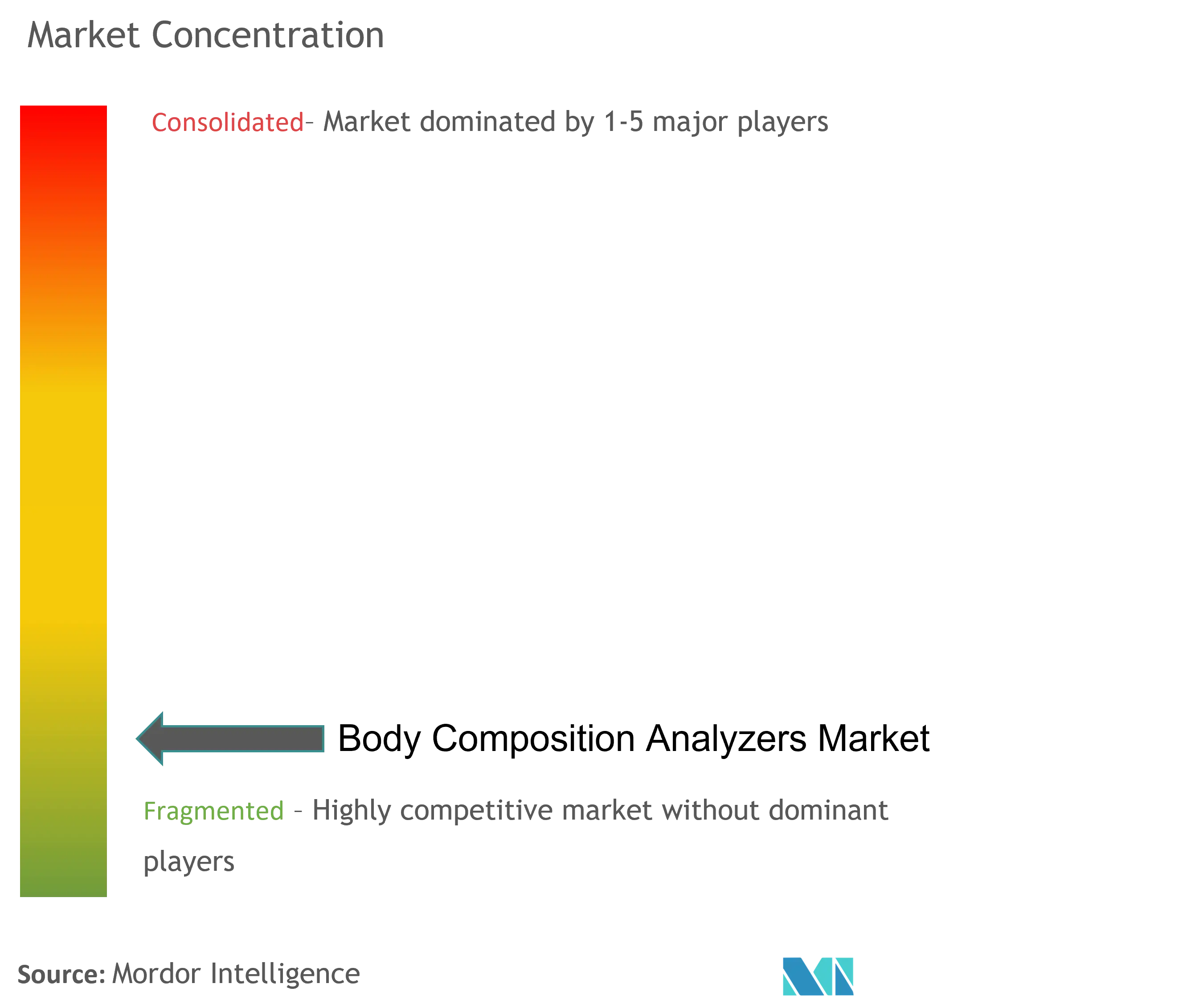
Body Composition Analyzers Market News
- January 2023: InBody reported supplying body composition analysis devices to the United States Marine Corps. The company will provide InBody's bioelectrical impedance analysis (BIA) technology devices to assess the fitness of marines.
- April 2022: InBody, a company specializing in body composition technology, launched the BWA 2.0 body water analyzer, which provides data on how body composition and body water affect well-being.
Body Composition Analyzers Market Report - Table of Contents
1. INTRODUCTION
- 1.1 Study Assumptions and Market Definition
- 1.2 Scope of the Study
2. RESEARCH METHODOLOGY
3. EXECUTIVE SUMMARY
4. MARKET DYNAMICS
- 4.1 Market Overview
-
4.2 Market Drivers
- 4.2.1 Large Pool of Obese Patients and Increasing Prevalence of Metabolic Disorders
- 4.2.2 Technological Advancements
- 4.2.3 Rising Awareness for Health and Fitness
-
4.3 Market Restraints
- 4.3.1 High Equipment Costs
- 4.3.2 Inconsistency and Inaccuracy in Different Analyzers
-
4.4 Porter's Five Forces Analysis
- 4.4.1 Threat of New Entrants
- 4.4.2 Bargaining Power of Buyers/Consumers
- 4.4.3 Bargaining Power of Suppliers
- 4.4.4 Threat of Substitute Products
- 4.4.5 Intensity of Competitive Rivalry
5. MARKET SEGMENTATION (Market Size by Value - USD million)
-
5.1 By Product
- 5.1.1 Bio-impedance Analyzer
- 5.1.2 Skinfold Calipers
- 5.1.3 Hydrostatic Weighing Equipment
- 5.1.4 Air Displacement Plethysmography
- 5.1.5 Dual Energy X-ray Absorptiometry
- 5.1.6 Other Products
-
5.2 By End User
- 5.2.1 Hospitals
- 5.2.2 Fitness Clubs and Wellness Centers
- 5.2.3 Academic and Research Centers
- 5.2.4 Other End Users
-
5.3 Geography
- 5.3.1 North America
- 5.3.1.1 United States
- 5.3.1.2 Canada
- 5.3.1.3 Mexico
- 5.3.2 Europe
- 5.3.2.1 Germany
- 5.3.2.2 United Kingdom
- 5.3.2.3 France
- 5.3.2.4 Italy
- 5.3.2.5 Spain
- 5.3.2.6 Rest of Europe
- 5.3.3 Asia-Pacific
- 5.3.3.1 China
- 5.3.3.2 Japan
- 5.3.3.3 India
- 5.3.3.4 Australia
- 5.3.3.5 South Korea
- 5.3.3.6 Rest of Asia-Pacific
- 5.3.4 Middle East and Africa
- 5.3.4.1 GCC
- 5.3.4.2 South Africa
- 5.3.4.3 Rest of Middle East and Africa
- 5.3.5 South America
- 5.3.5.1 Brazil
- 5.3.5.2 Argentina
- 5.3.5.3 Rest of South America
6. COMPETITIVE LANDSCAPE
-
6.1 Company Profiles
- 6.1.1 Bodystat Ltd
- 6.1.2 Cosmed Srl
- 6.1.3 Hologic Inc.
- 6.1.4 Inbody Co. Ltd
- 6.1.5 Omron Healthcare Inc.
- 6.1.6 Seca GmbH & Co. Kg
- 6.1.7 Tanita Corporation
- 6.1.8 Google (Fitbit Inc.)
- 6.1.9 Koninklijke Philips NV
- 6.1.10 Withings
- 6.1.11 EatSmart Inc.
- 6.1.12 Charder Electronic Co. Ltd
- *List Not Exhaustive
7. MARKET OPPORTUNITIES AND FUTURE TRENDS
Body Composition Analyzers Industry Segmentation
As per the scope of the report, the devices used for measuring diverse compounds present in the body and delivering their respective values at the examination point are body composition analyzers (BCA). Body composition analyzers have many applications in sports and medical research, especially causal association research studies in anthropology, nutrition, epidemiology, etc.
The body composition analyzers market is segmented by product (bio-impedance analyzer, skinfold calipers, hydrostatic weighing equipment, air displacement plethysmography, dual-energy x-ray absorptiometry, and other products), end user (hospitals, fitness clubs, and wellness centers, academic and research centers, and other end users), and geography (North America, Europe, Asia-Pacific, Middle East and Africa, and South America). The market report also covers the estimated market sizes and trends for 17 countries across major global regions. The report offers the value (in USD) for the above segments.
| By Product | Bio-impedance Analyzer | ||
| Skinfold Calipers | |||
| Hydrostatic Weighing Equipment | |||
| Air Displacement Plethysmography | |||
| Dual Energy X-ray Absorptiometry | |||
| Other Products | |||
| By End User | Hospitals | ||
| Fitness Clubs and Wellness Centers | |||
| Academic and Research Centers | |||
| Other End Users | |||
| Geography | North America | United States | |
| Canada | |||
| Mexico | |||
| Europe | Germany | ||
| United Kingdom | |||
| France | |||
| Italy | |||
| Spain | |||
| Rest of Europe | |||
| Asia-Pacific | China | ||
| Japan | |||
| India | |||
| Australia | |||
| South Korea | |||
| Rest of Asia-Pacific | |||
| Middle East and Africa | GCC | ||
| South Africa | |||
| Rest of Middle East and Africa | |||
| South America | Brazil | ||
| Argentina | |||
| Rest of South America | |||
Body Composition Analyzers Market Research FAQs
How big is the Body Composition Analyzers Market?
The Body Composition Analyzers Market size is expected to reach USD 639.00 million in 2025 and grow at a CAGR of 5.98% to reach USD 854.31 million by 2030.
What is the current Body Composition Analyzers Market size?
In 2025, the Body Composition Analyzers Market size is expected to reach USD 639.00 million.
Who are the key players in Body Composition Analyzers Market?
Bodystat, Inbody Co. Ltd., Charder Electronic Co, Ltd., Cosmed Srl and Hologic Inc. are the major companies operating in the Body Composition Analyzers Market.
Which is the fastest growing region in Body Composition Analyzers Market?
Asia Pacific is estimated to grow at the highest CAGR over the forecast period (2025-2030).
Which region has the biggest share in Body Composition Analyzers Market?
In 2025, the North America accounts for the largest market share in Body Composition Analyzers Market.
What years does this Body Composition Analyzers Market cover, and what was the market size in 2024?
In 2024, the Body Composition Analyzers Market size was estimated at USD 600.79 million. The report covers the Body Composition Analyzers Market historical market size for years: 2019, 2020, 2021, 2022, 2023 and 2024. The report also forecasts the Body Composition Analyzers Market size for years: 2025, 2026, 2027, 2028, 2029 and 2030.
Our Best Selling Reports
Body Composition Analyzers Market Research
Mordor Intelligence provides comprehensive insights into the BCA industry through a detailed analysis of the body composition analyzer market. Our expertise covers various technologies, including bioelectrical impedance analysis, DEXA scanner systems, and air displacement plethysmography. The report explores essential body composition measurement methods, ranging from traditional anthropometric measurement techniques to advanced body composition monitoring systems. Our analysis spans the complete spectrum of fitness testing equipment, such as skinfold caliper devices and sophisticated bioimpedance analyzer technologies.
Stakeholders gain valuable insights through our detailed BCA market analysis and BCA outlook. This information is available in an easy-to-access report PDF format for download. The research covers crucial aspects of body water analysis, body density measurement, and body fat measurement technologies. Our comprehensive assessment includes emerging trends in medical body composition analysis, fitness assessment equipment, and body scanning equipment. The report examines various applications of body fat analyzer technologies and hydrostatic weighing equipment, providing stakeholders with actionable intelligence for informed decision-making in this dynamic market landscape.

